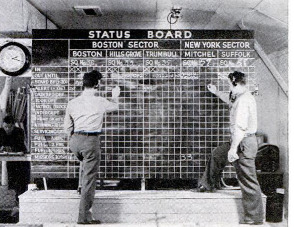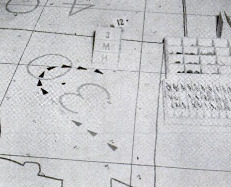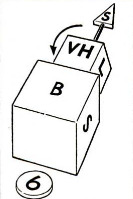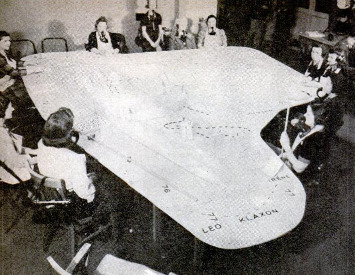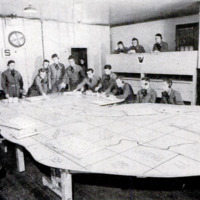Nerve center guards New York : army air corps sets up elaborate defense system
Item
-
Title (Dublin Core)
-
Nerve center guards New York : army air corps sets up elaborate defense system
-
Article Title and/or Image Caption (Dublin Core)
-
Title: Nerve center guards New York : army air corps sets up elaborate defense system
-
extracted text (Extract Text)
-
AMERICA’S most elaborate air-defense
information center has just been com-
pleted in New York City. It is the
best equipped in the world. Minute-by-
minute reports from more than 6,000 field
observers will enable Air Corps experts,
working at tables that resemble pieces from
a giant jig-saw puzzle, to plot the progress
of enemy bombers and to direct the swift
climb and attack of interceptor planes.
Even before the bombers reach the coast,
the Army’s latest locator system will spot
their position and, as soon as they wing
inland, observers at five-mile intervals will
flash in their reports—giving the type, num-
ber, height, and direction of the invading
planes. As each flash reaches the New York
nerve center, a marker, known as a ‘“plot-
ter’s pip,” will be placed on one of the jig-
saw tables at a point that coincides with
the position of the reporting observer. The
table is called the “filter board” because
here mistaken reports ave filtered out.
The men who place the markers on
the board are designated “plotters.”
| Behind the plotters stand the “eval-
uators.” As soon as these trained Air
sl Corps men decide the course the in-
y vaders are taking, they replace the
\ pips with arrows—colored red, blue,
N or yellow, according to the time of the
hour the reports are received. Instant-
| ly, “tellers,” sitting in a balcony over-
| looking the board, speak into tele-
phones and similar arrows appear on a
similar board in an adjoining room. This is
the “operations board” from which final
decisions are made.
There follows a swift succession of events.
In a soundproof balcony overlooking the
board, the controller, flanked by a pursuit
officer and a radio control officer, assigns
the invading “target” to one or more pur-
suit squadrons. In a matter of seconds, the
complicated machinery of aerial defense is
in full motion. Even before the interceptor
planes begin skyrocketing up from the air
field, pursuit officers in one of the six inter-
ceptor offices at the center are plotting the
best course for engaging the enemy. These
officers, in constant radio contact with the
fighting planes, direct the whole attack
from the ground. When plotting their navi-
gation charts, they use colored pencils,
changing every five minutes to coincide with
changes in the color of the arrows on the
operations board.
‘While this activity is going on, the civil
air-raid warden is flashing out warnings to
communities in the path of the attack;
noting down details of the raid for later
study; officers of the First Interceptor Com-
mand, watching a third board in another
room, are keeping track of developments
and codrdinating activity throughout an
area that extends from Maine to below Cape
Hatteras and from the Atlantic Coast as
far west as Minnesota.
This vast area will be safeguarded by 13
information centers, each in a major city.
Every center will have an auxiliary station
ready to take over in less than eight min-
utes if the main center is destroyed or
disabled. In New York, for example, is
located the auxiliary filter board for Scran-
ton, Pa. In all parts of the country, air de-
fense nerve centers, similar to the one in
New York City, are under construction. In
the near future, between 30 and 40 will
stand guard, fully equipped for emergencies.
-
Language (Dublin Core)
-
Eng
-
Date Issued (Dublin Core)
-
1941-10
-
pages (Bibliographic Ontology)
-
89-91
-
Rights (Dublin Core)
-
Public domain
-
Archived by (Dublin Core)
-
Sami Akbiyik
 Popular Science Monthly, v. 139, n. 4, 1941
Popular Science Monthly, v. 139, n. 4, 1941

